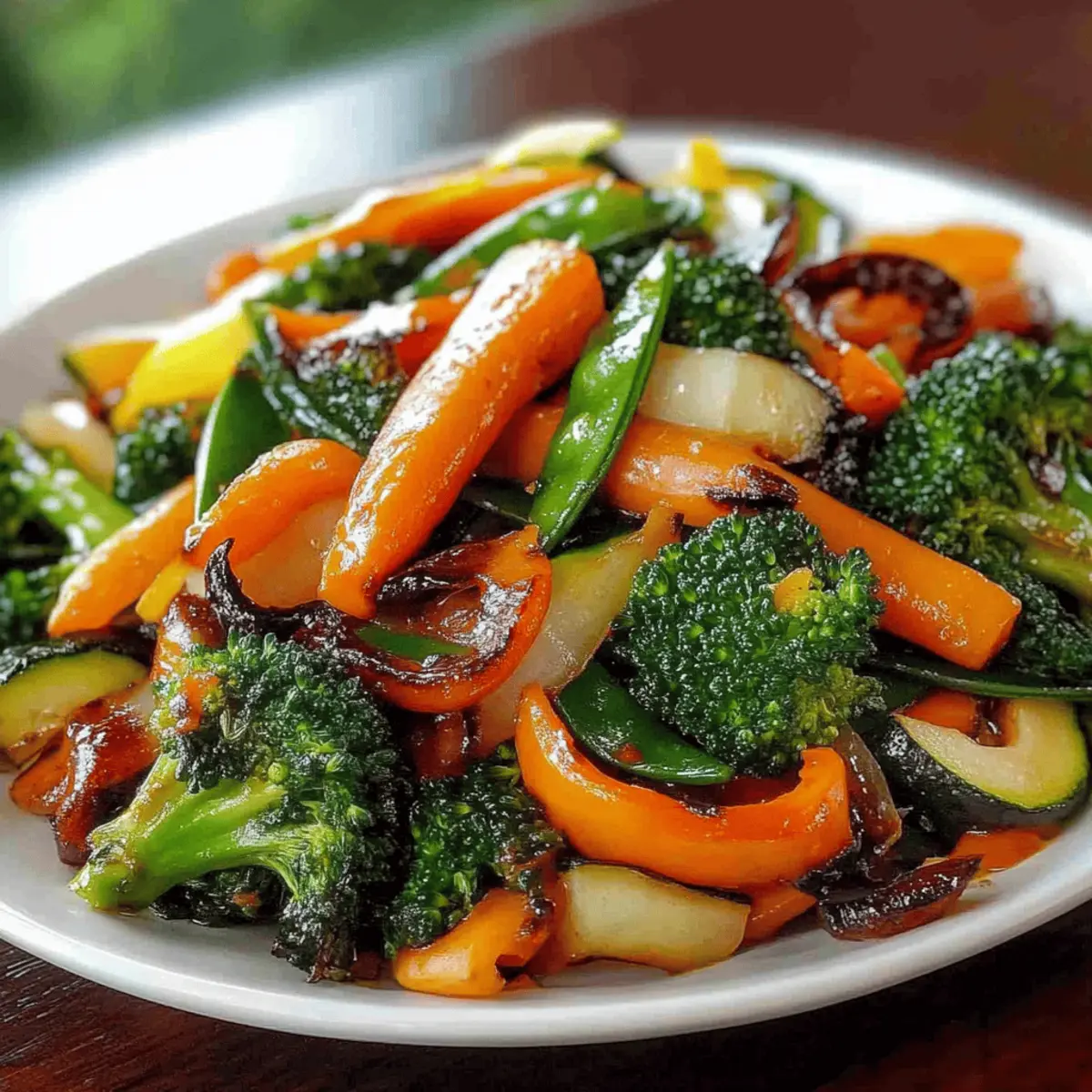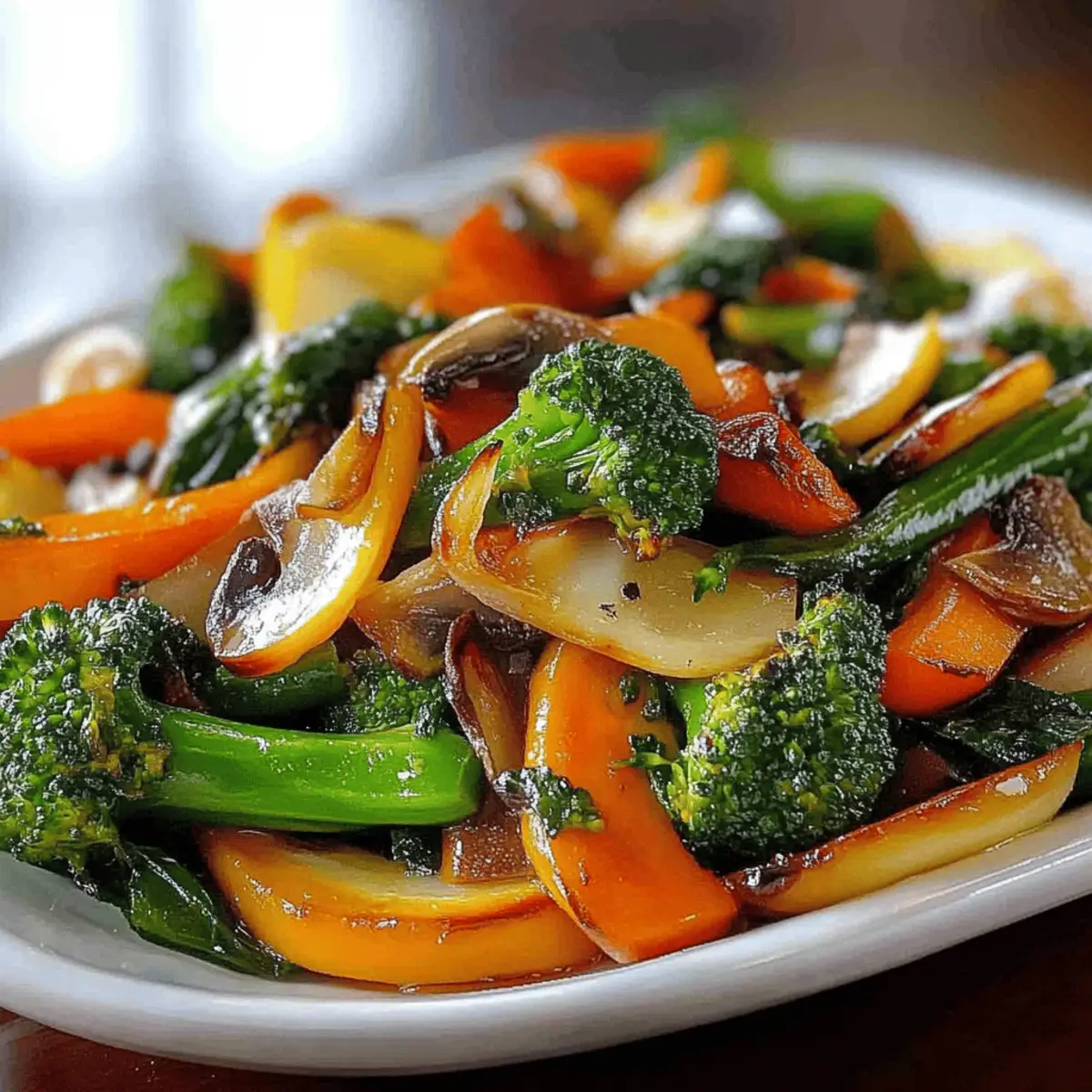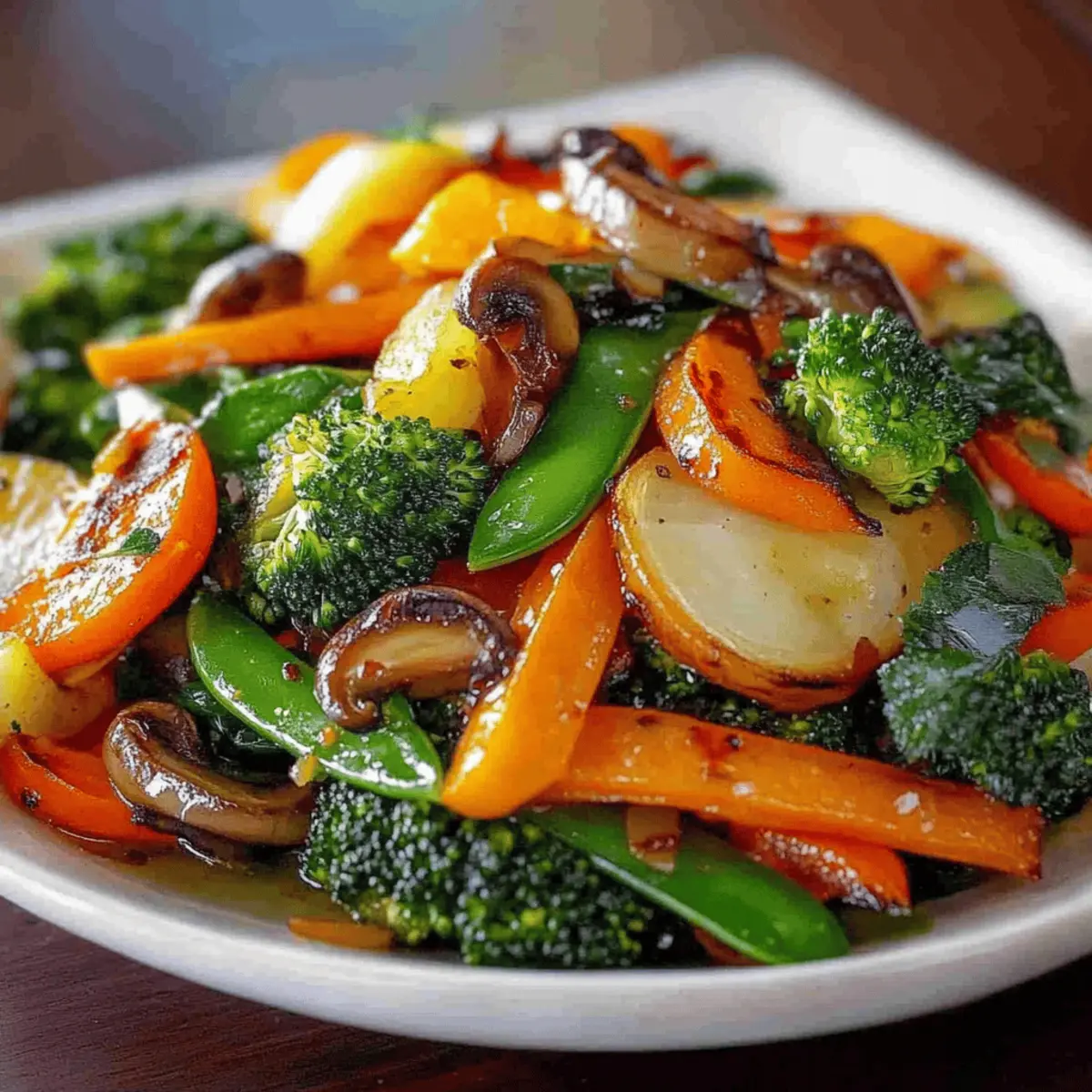As I stood in my kitchen, the vibrant colors of fresh vegetables caught my eye, bringing an immediate sense of excitement. Crafting a dish filled with Healthy Sautéed Vegetables is not just about cooking; it’s a celebration of the bright, nutritious ingredients that can transform any meal. This quick and colorful side dish is perfect for busy weeknights, offering an effortless way to sneak in more veggies without sacrificing flavor or texture. Packed with a rainbow of seasonal produce, it’s not only a nutrient powerhouse but also a versatile companion—whether paired with grilled chicken, a hearty grain bowl, or enjoyed as a stand-alone vegan delight. Are you ready to unleash your creativity with these colorful veggies? Let’s dive into this delicious journey together!

Why You’ll Love These Sautéed Vegetables
Vibrant Colors: Each vegetable adds a burst of color to your plate, making healthy eating visually appealing and exciting.
Quick Preparation: Ready in just 15 minutes, these sautéed vegetables are ideal for those busy weeknights when time is of the essence.
Flavorful Versatility: Customize your dish with various seasonings or flavors like lemon zest or soy sauce to match your craving or meal theme.
Nutrient-Packed: Loaded with fiber, vitamins, and antioxidants, this dish is a delicious way to boost your nutrient intake effortlessly.
Meal Prep Friendly: Ideal for make-ahead meals, you can store them in an airtight container and enjoy them for up to 4 days, perfect for prepped lunches or dinners.
Elevate your meals by pairing these colorful vegetables with a Light Healthy Broccoli or mix in some grains for a complete dish!
Healthy Sautéed Vegetables Ingredients
• Discover the delicious components that make this dish shine!
For the Sauté
- Olive Oil – A fantastic cooking medium for sautéing; avocado oil or butter can be used for a different taste experience.
- Garlic – Delivers an aromatic kick; fresh minced garlic elevates the overall flavor.
- Onion – Offers sweetness and depth; opt for shallots if you prefer a milder taste.
For the Veggies
- Bell Pepper – Brings vibrant color and delightful crunch; don’t hesitate to mix and match different colors!
- Zucchini – Provides a tender texture; yellow squash makes for a lovely alternative.
- Broccoli Florets – Packed with nutrition and a satisfying crunch; green beans serve as a great substitute.
- Carrot – Adds natural sweetness and crunch; slice thinly for quicker cooking.
- Snap Peas – Imparts a sweet and crisp element; feel free to replace them with snow peas.
- Mushrooms – Adds an umami touch along with diverse texture; try portobello or shiitake mushrooms for more depth.
For the Seasoning
- Salt and Pepper – Essential seasonings that enhance the flavors; adjust according to your taste.
- Lemon Juice – Brightens the dish with acidity; vinegar (like balsamic or rice) makes a great alternative.
For the Finishing Touch
- Optional Toppings – Elevate your dish with toasted nuts or seeds for a bit of crunch, fresh herbs for brightness, or grated Parmesan for a rich finish.
Dive into the world of Healthy Sautéed Vegetables and let your culinary creativity shine!
Step‑by‑Step Instructions for Healthy Sautéed Vegetables
Step 1: Prep Vegetables
Begin by washing all your vegetables thoroughly. Peel the carrot if preferred, then cut it, along with the onion, bell pepper, zucchini, broccoli, and mushrooms, into uniform pieces to ensure even cooking. Aim for bite-sized chunks, and keep snap peas whole for added crunch. This preparation sets the stage for a vibrant and colorful Healthy Sautéed Vegetables dish.
Step 2: Heat Pan
Place a large skillet over medium-high heat and allow it to preheat for about 2 minutes. Once hot, pour in 1 to 2 tablespoons of olive oil, swirling it around to coat the bottom of the pan evenly. You’ll know it’s ready when the oil shimmers and slightly ripples, indicating it’s time to add your aromatics and begin bringing those flavors to life!
Step 3: Cook Aromatics
Add minced garlic and diced onion to the skillet and sauté for 1 to 2 minutes. Stir continuously until the onions turn translucent and aromatic, a visual cue that enhances the flavor foundation for your Healthy Sautéed Vegetables. Be careful not to let the garlic brown, as it can become bitter and spoil the vibrant taste you’re building.
Step 4: Add Harder Vegetables
Introduce the chopped carrots and broccoli to the pan, cooking them for 3 to 4 minutes. Stir frequently to prevent sticking and ensure even cooking. You want these vegetables to soften slightly while keeping a crisp texture. The broccoli should become bright green and the carrots tender yet crunchy, creating a satisfying contrast as we layer in more flavors.
Step 5: Add Softer Vegetables
Now, it’s time to bring in the bell peppers, zucchini, mushrooms, and snap peas. Sauté everything together for an additional 4 to 5 minutes, stirring often. The goal is to achieve a crisp-tender texture where the vegetables retain their vibrant colors and individual flavors. Keep an eye on them; you want the zucchini to be fork-tender, while still maintaining some bite.
Step 6: Season
Sprinkle salt and pepper over the sautéed vegetables, along with any optional seasonings you desire, such as a splash of lemon juice or soy sauce. Stir everything well, allowing the flavors to meld and the vegetables to warm through for another minute. The seasoning will enhance the natural taste of the veggies, resulting in a robust and delightful Healthy Sautéed Vegetables dish.
Step 7: Finish & Serve
After ensuring everything is well combined and heated, remove the skillet from the heat. Toss the vegetables once more for an even distribution of flavors, and then transfer the colorful mix to a serving platter. Consider garnishing with fresh herbs, toasted nuts, or grated Parmesan for an extra touch. Serve your Healthy Sautéed Vegetables immediately to enjoy their fresh and vibrant texture.

Expert Tips for Healthy Sautéed Vegetables
Avoid Overcrowding: Cooking in batches is key; overcrowding can lead to steaming instead of sautéing, affecting flavor and texture.
Use High Heat: Maintain a medium-high temperature to keep the vegetables vibrant and crisp-tender, maximizing the health benefits of your healthy sautéed vegetables.
Prep Ahead: Chop vegetables in advance to save time on busy evenings, ensuring freshness when you’re ready to cook.
Correct Seasoning: Season to taste at the end to avoid over-salting; remember, fresh ingredients often enhance flavor naturally.
Quick Serving: Serve immediately to enjoy the optimal texture and flavor—these vibrant sautéed vegetables are best piping hot!
How to Store and Freeze Healthy Sautéed Vegetables
Fridge: Store leftovers in an airtight container for up to 3-4 days. Reheat quickly in a skillet over medium heat to restore their vibrant texture.
Freezer: For longer storage, freeze cooked sautéed vegetables in a single layer on a baking sheet. Once frozen, transfer them to a freezer-safe bag or container for up to 3 months.
Reheating: When ready to enjoy, reheat frozen Healthy Sautéed Vegetables in a skillet over medium heat, adding a splash of water to help them cook evenly without losing texture.
Meal Prep: Chop vegetables ahead of time and store them in the fridge for up to 2 days. This allows for easy assembly during busy weeknights!
Make Ahead Options
These Healthy Sautéed Vegetables are an excellent choice for meal prep enthusiasts! You can chop all your vegetables up to 24 hours in advance and store them in an airtight container in the refrigerator to maintain freshness. To keep them looking vibrant and tasty, cover them with a damp paper towel before sealing. When you’re ready to enjoy, simply heat 1-2 tablespoons of olive oil in your skillet, sauté the aromatics, then add your prepped veggies and cook for 4-5 minutes until crisp-tender. This way, you’ll have a quick and delicious side dish ready in minutes, perfect for busy weeknights or lunches!
What to Serve with Healthy Sautéed Vegetables
Elevate your dining experience by pairing these vibrant and nutritious sautéed vegetables with delightful sides that complement their fresh flavors.
-
Grilled Chicken: Juicy and tender, grilled chicken adds a protein punch, balancing the crisp textures of the sautéed vegetables while enhancing the meal’s heartiness.
-
Quinoa Salad: This nutty and fluffy grain is rich in protein and fiber, creating a satisfying contrast that rounds out your plate beautifully, making it a perfect accompaniment.
-
Brown Rice: Its chewy texture and earthy flavor provide a wholesome base, soaking up any flavors from the sautéed veggies, while offering a fulfilling completion to your meal.
-
Crispy Tofu: Marinated and baked to perfection, crispy tofu introduces a delightful crunch and plant-based protein, making it a fantastic option for vegetarians.
-
Lemon Herb Couscous: Light and fluffy with a zesty punch, this dish accentuates the freshness of your vegetables, bringing a bright and sunny note to your table.
-
Roasted Salmon: Rich in omega-3s, the buttery flavor of roasted salmon complements the medley of vegetables beautifully, creating a harmonious and nutritious dinner option.
-
Garlic Bread: An indulgent yet simple side that provides a satisfying crunch, it perfectly balances the healthy sautéed vegetables, making it a comforting choice for family meals.
-
Sparkling Lemonade: A refreshing drink option, the zesty sweetness of sparkling lemonade pairs well with the sautéed vegetables and adds a cheerful touch to your dining experience.
Healthy Sautéed Vegetables Variations
Feel free to get creative and make this dish your own, infusing it with unique flavors and textures that excite your palate!
-
Asian-Inspired: Add soy sauce, sesame oil, ginger, and a sprinkle of sesame seeds for an exotic touch. Consider serving it alongside some fluffy jasmine rice to create a nourishing meal.
-
Mediterranean Twist: Drizzle with olive oil, toss in lemon zest, oregano, and finish with crumbled feta cheese that melts beautifully into the warmth of the vegetables. This variation pairs wonderfully with a refreshing Greek salad or pita bread.
-
Spicy Kick: If you love a little heat, add a dash of chili flakes or a splash of sriracha for an enticing zing. This fiery twist can elevate the dish, making it a fantastic complement to grilled meats or tofu.
-
Herb-Forward: Fresh herbs like thyme, rosemary, or basil can enhance the subtle flavors of your sautéed vegetables. You might like to pair this variation with a hearty pasta or a warm grain salad for a balanced meal.
-
Nutty Flavor: Stir in toasted nuts, such as almonds or pine nuts, to add crunch and that delightful roasted flavor. This brings an extra layer of richness when served alongside dishes like Healthy Carrot Cake for a sweet balance.
-
Creamy Addition: Stir in a splash of heavy cream or a dollop of crème fraîche at the end for a luscious finish. This rich variation makes every bite exceptionally comforting—perfect over a bed of fluffy rice or quinoa.
-
Zesty Citrus: Replace lemon juice with lime juice or orange juice for a bright and refreshing twist. This zesty flare pairs beautifully with dishes like Healthy Sautéed Vegetables served alongside fish or chicken.
-
Gourmet Touch: Elevate the dish with a sprinkle of truffle oil at the end for a luxurious experience. This refined variation can transform a simple meal into an elegant dining experience, perfect for impressing guests.

Healthy Sautéed Vegetables Recipe FAQs
What should I look for when selecting vegetables?
Absolutely! When choosing vegetables for your Healthy Sautéed Vegetables, look for vibrant colors and firm textures. Avoid any produce with dark spots or mushiness. For example, snap peas should be crisp and bright green, while bell peppers should feel smooth and firm to the touch.
How should I store leftover sautéed vegetables?
To keep your Healthy Sautéed Vegetables fresh, store them in an airtight container in the refrigerator for up to 3-4 days. When you’re ready to enjoy them again, simply reheat them in a skillet over medium heat for a few minutes. This method helps restore their delightful textures!
Can I freeze sautéed vegetables, and if so, how?
Of course! To freeze your Healthy Sautéed Vegetables, start by placing them in a single layer on a baking sheet and freeze until solid—about 1-2 hours. After that, transfer them to a freezer-safe bag or container. They can be stored this way for up to 3 months. When you’re ready to enjoy them, reheat in a skillet over medium heat, adding a splash of water to help retain their texture.
How can I prevent my vegetables from getting soggy while cooking?
Very! To prevent sogginess, avoid overcrowding the pan, as this traps steam and reduces crispiness. Instead, sauté in batches if necessary. Additionally, make sure to use high heat during cooking to keep the veggies juicy yet firm—perfect for a healthy sautéed vegetable dish!
Are there any dietary considerations for this recipe?
Yes! This recipe is inherently vegetarian and vegan, making it accessible to many diets. If serving to pets or individuals with allergies, be cautious with non-vegetarian toppings like cheese or certain nuts. Always check for individual sensitivities, especially with ingredients like soy sauce and garlic.
Can I make this recipe ahead of time?
Absolutely! You can chop your vegetables ahead of time and store them in the refrigerator in a sealed container for up to 2 days, allowing for quick assembly on busy evenings. This way, enjoyable meals become hassle-free without sacrificing nutrition.
Enjoy creating your culinary marvel with Healthy Sautéed Vegetables Recipe FAQs!

Deliciously Colorful Healthy Sautéed Vegetables in Minutes
Ingredients
Equipment
Method
- Wash all your vegetables thoroughly. Peel the carrot if preferred, then cut it, along with the onion, bell pepper, zucchini, broccoli, and mushrooms, into uniform pieces.
- Place a large skillet over medium-high heat and preheat for about 2 minutes. Pour in 1 to 2 tablespoons of olive oil.
- Add minced garlic and diced onion to the skillet and sauté for 1 to 2 minutes until onions are translucent.
- Introduce chopped carrots and broccoli to the pan, cooking for 3 to 4 minutes.
- Bring in the bell peppers, zucchini, mushrooms, and snap peas. Sauté for an additional 4 to 5 minutes.
- Sprinkle salt and pepper over the vegetables, along with optional seasonings, and stir well.
- Remove the skillet from heat, toss the vegetables, and serve immediately.

Leave a Reply